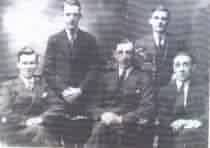|
ER COF
AM Y 266 O LOWYR A GOLLODD
EU
BYWYDAU YN NHANCHWA
GWAITH GLO GRESFFORDD
MEDI 22ain 1934
IN MEMORY
OF THE 266 MINERS
WHO LOST
THEIR LIVES
IN THE
GRESFORD COLLIERY DISASTER
22nd SEPTEMBER 1934
At about 2am, in the morning on Saturday 22nd September 1934,
an explosion occurred in the Dennis Section of Gresford Colliery, just outside Wrexham, in Denbighshire, Wales. It was at
the time when many of the men might have been taking their break in the middle of the shift that had started the night before,
on Friday 21st September at 10-00pm. Some 800 children lost their fathers and more than 200 women lost their husbands and
sweethearts.
One of the most appalling disasters in the history of British mining
occurred at the Gresford Colliery, owned by the Westminster and United Collieries Group. The mine operated in two main
sections, the Dennis and the Slant. The explosion occurred in the Dennis, one of the deepest pits in the North Wales coalfields.
The Dennis Main Deep was ruptured by the explosions, and many miners would have been flung across the pit roads, some of them
dying instantly. Others were burnt alive, gassed, asphyxiated or crushed to death. There is no doubt that there were others
trapped alive with no means of escape who were the victims of later explosions and the release of more gas, and who were dead
before they were entombed forever by the sealing of the mine by their colleagues.
Only six men in the Dennis survived the explosion.
Within a few hours of the first explosion, more than 1000 men had assembled
at the pithead in the cold and pouring rain, waiting to help their comrades, sealed behind a wall of fire, two miles from
the bottom of the downtake shaft. This needs to be understood in the context of the times and the communications technology
of the day.
The Chronicle reporter writes "As the pit cage wheels turned, the large
crowds were scattered over the pit banks, and all over the colliery yard, and the highest bank was thick with silent men standing
in the rain, waiting and watching. The saddest confirmation was soon available. The wheels of the winding shaft began their
revolutions once more, and I saw two of the rescue party brought up - dead". There was a call for 20 volunteers, and 100 men
stepped forward. Nobody spoke. The women stood quietly in the rain.
Shortly after 8-00pm on Sunday night, the following official statement
was issued :
 |
 |
|
Sunday
September 23 1934, 7-45pm "The attempt to overcome the fire in the main road has gone on continually since
yesterday, but in spite of very strenuous efforts, and although some progress has been made in this road, the fire has got
a further hold in a road to the right, through which it was hoped access would have been got to any possible survivors. "Today
several explosions in bye of the fire in the main road have occurred, and this afternoon they became more frequent and closer
to where the men were working on the fire. "The return air in both main returns is carrying carbon-monoxide in dangerous quantity, and it is with great reluctance that all parties - the management, the representatives of
the miners and H.M Inspectors - have come to the conclusion that no person can possibly be alive in the workings. "In these
circumstances and in view of the increasingly grave risk to the men combating the fire, it has been decided that it would
not be right to continue to expose these workers to such serious risk, and all persons have been withdrawn from the mine.
H. DYKE DENNIS, EDWARD JONES, H.WALKER
|
| |
|
 |
 |
Some 260 men were entombed behind a wall of fire and for two days,
brave men fought to reach their entrapped colleagues - and then came the dreaded decision to withdraw the would-be rescuers
and seal the pit shaft with the men inside.... and so the inevitable happened ... the mine was sealed, and it stays so today
... more than fifty years on ... the roads and shafts burnt and collapsed, forever entombing the bodies of 256 men and boys
.... "don't send your sweethearts down a dark, dreary mine ... they'll be lost like the souls in hell".
Sir Stafford Cripps lead the investigation into the disaster, and this
inquiry ended two and a half years later, when the report was tabled in Parliament. In 1937, proceedings were started against
the Manager of the mine, the under Manager, firemen individually and jointly against United and Westminster Collieries Limited,
and hearings commenced on 20 April 1937 at Wrexham County Petty Sessions Court.
The Gresford Colliery continued to be worked, but not the Dennis Section.
Mining at Gresford in the Slant District continued until 23 October 1973, but the pit was closed officially on economic grounds
on 10 November 1973.
|
 |
|

from Roy Lambeth
thanks Roy!
the community website
those that died.
thanks to the folks
at the Welsh Coal Mines
website for this list
once more massive thanks
go to Roy Lambeth, whose researches
into the Gresford Disaster
are second to none
 |
 |
|
The Six Survivors
Names
Ted Andrew
Cyril Challinor
Thomas Fisher
Davy Jones
Burt
Samuels
Jack Samuels
|
| |
|
 |
 |
|
 |
 |
 |
|
 |
 |
|
The Gresford Disaster
The epic track on the album
"Rise Up Like the Sun"
recorded by The Albion Band
in 1978 tells the story of the
The Albion Band did the research
into the song, and found that
it had been written in the form
of the great, black-lettered,
broadside ballads to raise funds
for those who had been
widowed and orphaned
by the accident He also discovered
that the colliery band was at
the pithead as the bodies
were being brought out,
playing to try and raise the spirits
of the wives, children and
friends who were waiting.
One "tune" the colliery band is
known to have played was
"How Sweet the Name of Jesus Sounds",
which was written by
D.H. Lawrence's great-grandfather
(now there's a bit of historical trivia !).
John Tams decided tofit the words
to the hymn and
produce it as a
ballad.
There is a live and slightly
longer version of
The Gresford Disaster
on the Albion Band
Live in Concert album
this is the version link to above.
|
| |
|
 |
 |

|
| compiled by Stanley Williamson. Liverpool University Press 1999 |
|
|
 |
 |
 |
|
|
|

